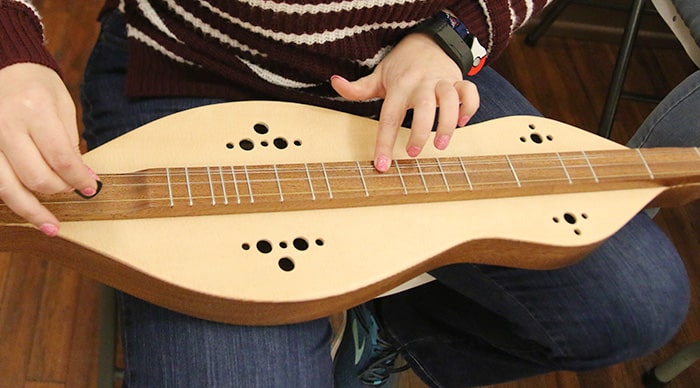There are many things to look for when selecting a mountain dulcimer. While some are important and speak to the quality of the instrument, others are based on musician taste.
Generally speaking, we recommend speaking to existing mountain dulcimer players – either from a local club, a class, a festival, or at a dealership. These folks should be able to guide you with their experiences. For those who are interested in purchasing a mountain dulcimer online, there are a few things you should consider.
Overall Construction
Mountain dulcimers are beautiful instruments, and are typically shaped like an hourglass or teardrop shape. Some players report that certain shapes can result in different tonal qualities. But in our experience, there are other qualities of the instrument that affect the sound more than the overall shape.
Sound Quality
The most important factor is the tone. Play several dulcimers and listen for the warmth and richness of the sound. A good dulcimer should produce clear, resonant tones without being too tinny or muffled.
Volume is another characteristic to look for when selecting a dulcimer. A louder, more resonant sound is often desired, but some people prefer a quieter instrument for practice purposes.
But really, the type of sound produced is entirely based on personal preference. It helps to know someone who owns a mountain dulcimer, so you can play it yourself to determine which sound you most prefer.
Material & Build
The type of wood used in the top soundboard can have a dramatic effect on the tonal quality of the instrument. Softer woods, such as cedar and spruce, produce a warmer sound while harder woods, such as maple, cherry, or walnut, produce a brighter, crisper sound. Builders sometimes use different types of wood for different parts of the instrument.
Top soundboard: Spruce is a popular choice because it provides a bright, clear tone.
Back and sides: Maple, walnut, or mahogany give different tonal qualities. Maple often provides a bright sound, while mahogany or walnut can offer a richer, deeper tone.
Look for a dulcimer with clean, precise craftsmanship. Avoid instruments with visible gaps or uneven finishes. A well-made dulcimer will be more durable and sound better. Our list of dulcimer builders by region may help.
Make sure the tuning pegs are smooth and stable. Cheap or loose tuners can make tuning a hassle and could affect the instrument’s ability to stay in tune.
Frets and Tuning
Mountain dulcimers typically come with either 4 or 6 strings and a range of frets. A 4-string dulcimer (usually tuned in DAD) is a common choice for beginners, as it’s simpler and more intuitive to play. A 6-string dulcimer offers more versatility but may be a little more complex.
Look at the fretboard to ensure it is well-marked, with consistent fret placement. Some dulcimers have a diatonic fretboard (which makes it easier to play in certain keys), while others are chromatic (offering more flexibility in tuning).
Side Depth
Another quality that can affect tonal quality is the depth of the instrument. When comparing mountain dulcimers, those with thicker sides generally produce deeper tones since the resonating cavity is larger in volume. Again, it helps to play different dulcimers side-by-side if possible.
Bridge Placement
The placement of the bridge has evolved over time. Historically, dulcimer builders placed the bridge near the bottom (or “tail”) of the instrument. These are becoming harder and harder to find.
Modern day builders typically place the bridge over the soundboard which gives the instrument more of a guitar-like sound. This is something that mountain dulcimer players are starting to prefer and, as a result, the market is responding accordingly.
String Length
The length of strings that connect the tuning pegs to the bridge (sometimes called vibrating string length) can sometimes affect the playability of the instrument. Typically the string length varies between about 24” to 28”. And that difference of 4” dictates the required spacing between the frets.
In other words, as the length of the strings increase, the spacing between frets increases as well. While this doesn’t necessarily impact the tonal quality of the instrument, it could make it harder to play for those with smaller hands because of the need to stretch your fingers.
Playability
Ensure that the neck feels comfortable to your hand, with no sharp edges or uncomfortable parts. The fingerboard should be smooth and easy to navigate.
The distance between the strings and the fretboard (known as action) should be low enough to make playing easy. However, it should not be so low that the strings buzz against the frets.
Consider how the dulcimer feels when you hold it. Some people prefer a lighter, more compact instrument, while others prefer a larger, heavier one. Your comfort while playing is key, especially for longer practice sessions.
Budget
Cost is the most obvious differentiator when choosing mountain dulcimers. For player with some experience under their belt, we recommend going with the most expensive option you can afford. This will ensure an instrument of fine craftsmanship which can be passed down as a family heirloom.
Of course, when first starting out it makes most sense to seek out the most economical option to determine is this is a craft you’d like to pursue.
Reviews and Recommendations
Research reviews, or ask other dulcimer players for recommendations. Some brands and makers are known for their quality, such as McSpadden, among others.
Visiting a local music store to try different options is also helpful.
Final Thoughts
Hopefully this article will help you in deciding what to look when purchasing a new or used mountain dulcimer. Having the ability to test drive some instruments in person – either through a local club, a festival, or dealership – is your best bet. But if not, there are still some great choices available online.
One that we particularly like is the Roosebeck DMCRT4 4-String Cutaway Mountain Dulcimer. Both beginner and experienced players alike have many positive things to say about this instrument.
Regardless of which you choose, you’re making an investment in yourself and your musical journey so enjoy the ride.




